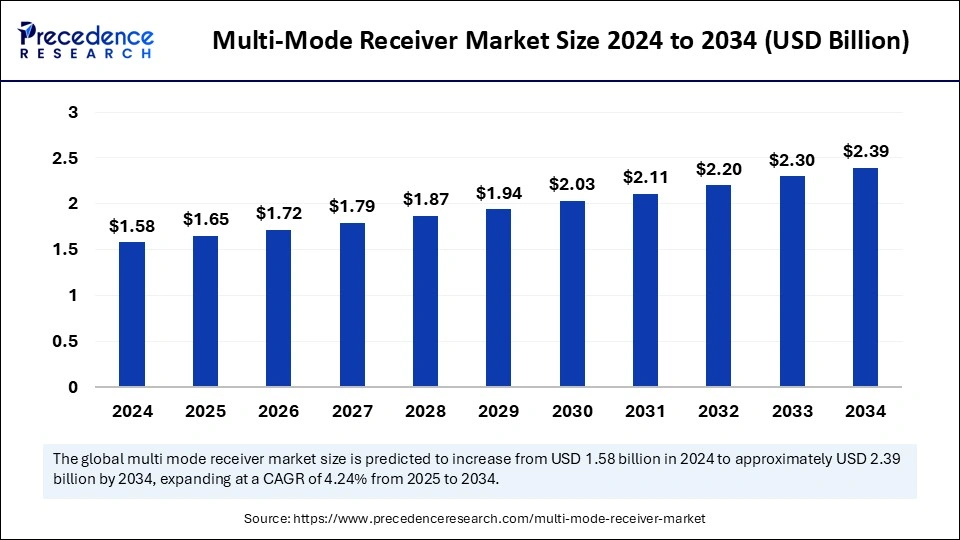The global multi-mode receiver market size was valued at USD 1.58 billion in 2024 and is expected to attain around USD 2.39 billion by 2034, growing at a CAGR of 4.24%.

Get a Free Sample Copy of the Report@ https://www.precedenceresearch.com/sample/5806
Multi-Mode Receiver Market Key Insights
-
North America captured a 38% share of the market in 2024, leading all regions.
-
Asia Pacific is predicted to grow at the highest CAGR through the forecast duration.
-
The fixed-wing platform was the top contributor with 64% market share in 2024.
-
Rotary-wing systems are set to grow more rapidly compared to other platforms.
-
The line-fit installation method held the largest portion of the fit market in 2024.
-
Retrofit installations are poised for fast-paced growth moving forward.
-
Navigation and positioning held the leading spot in applications for 2024.
-
Landing applications are expected to show strong expansion in the coming years.
-
Aerospace and defense were the dominant end-use industries in 2024.
-
Telecommunication will likely show the highest growth rate by end use.
How AI is Transforming Multi-Mode Receivers ?
Artificial Intelligence is playing a transformative role in the Multi-Mode Receiver (MMR) market by enhancing real-time data processing, decision-making, and system adaptability. AI algorithms enable MMRs to interpret vast amounts of navigation, communication, and surveillance data with greater speed and accuracy. This integration allows for smarter switching between navigation modes (such as GPS, ILS, and GLS), improving situational awareness and flight safety—especially in complex or congested airspaces.
Additionally, AI is contributing to predictive maintenance and fault detection in avionics systems, including MMRs. By analyzing sensor data trends, AI can predict equipment malfunctions before they occur, reducing downtime and maintenance costs. As the aviation industry pushes for autonomous and AI-powered flight systems, the role of intelligent, adaptive MMRs will continue to grow—driving innovation in both civil and military aerospace applications.
Market Overview
The multi-mode receiver market is experiencing strong growth due to its critical role in enhancing navigation, communication, and positioning accuracy across various sectors such as aerospace, defense, and transportation. Multi-mode receivers (MMRs) integrate multiple navigation systems, including GPS, GLONASS, Galileo, and BeiDou, to ensure high reliability and accuracy even in challenging environments. The growing need for seamless interoperability, real-time data processing, and secure communication has driven the adoption of MMRs, particularly in aviation for advanced flight management systems and autonomous operations.
Market Scope
| Report Coverage | Details |
| Market Size by 2034 | USD 2.39 Billion |
| Market Size in 2025 | USD 1.65 Billion |
| Market Size in 2024 | USD 1.58 Billion |
| Market Growth Rate from 2025 to 2034 | CAGR of 4.24% |
| Dominated Region | North America |
| Fastest Growing Market | Asia Pacific |
| Base Year | 2024 |
| Forecast Period | 2025 to 2034 |
| Segments Covered | Platform, Fit, Application, End Use, and Regions |
| Regions Covered | North America, Europe, Asia-Pacific, Latin America and Middle East & Africa |
Market Dynamics
Market Drivers
One of the major drivers of the market is the increasing focus on next-generation aircraft modernization and the integration of advanced navigation systems. The rising number of aircraft deliveries and the demand for safer, more efficient air traffic management systems also contribute significantly to market growth. Furthermore, the adoption of Performance-Based Navigation (PBN) and satellite-based augmentation systems (SBAS) in aviation regulations worldwide is fueling the demand for reliable multi-mode receivers. Additionally, the growing interest in UAVs (unmanned aerial vehicles) and urban air mobility solutions is accelerating the use of MMRs in both military and commercial domains.
Market Opportunities
Significant opportunities lie in the integration of AI and machine learning with multi-mode receiver technology. These advancements are enabling real-time decision-making, predictive maintenance, and enhanced situational awareness, particularly for autonomous systems. Moreover, the increasing deployment of 5G networks and smart transportation systems is opening new avenues for MMRs to be used in automotive and telecommunication applications. The expansion of commercial space operations and the growing need for precision navigation in emerging markets also present new opportunities for manufacturers and solution providers.
Market Challenges
Despite the promising outlook, the multi-mode receiver market faces several challenges. The high cost of development and integration, especially in retrofitting older systems, can limit widespread adoption. Technical complexities in synchronizing signals from multiple navigation systems can also pose reliability issues in high-stakes environments like military and aerospace. Additionally, the risk of cybersecurity threats and jamming/spoofing of satellite signals remains a concern that must be addressed through advanced encryption and signal protection technologies.
Regional Insights
North America currently dominates the multi-mode receiver market due to its robust aerospace and defense infrastructure, coupled with continuous investments in advanced avionics and autonomous technologies. The presence of leading players and high R&D spending further strengthens its market position. Asia Pacific is anticipated to witness the fastest growth, driven by increasing air passenger traffic, defense modernization efforts, and the rapid expansion of smart city projects. Meanwhile, Europe is steadily advancing in the market, with countries like Germany, France, and the UK focusing on sustainable aviation, green mobility, and the integration of GNSS technologies into various industrial applications.
Multi-Mode Receiver Market Companies

- AE Systems
- Garmin Ltd.
- Honeywell International Inc.
- Indra Sistemas
- Intelcan Technosystems Inc.
- Leonardo S.p.A.
- Deere & Company
- Collins Aerospace
- Saab AB
- systems interface (FREQUENCIES)
- Thales
- Trimble
- VAL Avionics Ltd.
Latest Announcements by Market Leaders
- In December 2024, Honeywell announced the signing of a strategic agreement with Bombardier, a global leader in aviation and manufacturer of world-class business jets, to provide advanced technology for current and future Bombardier aircraft in avionics, propulsion, and satellite communications technologies. The collaboration will advance new technology to enable a host of high-value upgrades for the installed Bombardier operator base.
- In March 2025, Garmin, the world’s most innovative and recognized marine electronics manufacturer, announced Force® Pro – a brushless trolling motor engineered with extreme power and Garmin’s most precise GPS positioning technology. It gives anglers everything they love about Force, now with multi-band GPS for superior anchor lock performance and a built-in GT56UHD.
Recent Developments
- In 2024, Collins Aerospace is collaborating with the European Agency for Space Programme (EUSPA) on the Multi-Mode Global Positioning System and Galileo (MUGG) project to enhance the resilience and availability of commercial navigation systems. This initiative focuses on developing a dual-frequency, multi-constellation satellite-based augmentation system (SBAS) receiver.
- In December 2024, Honeywell revealed that Avianca chose its avionics and mechanical systems for its new Airbus A320neo fleet to optimize operational performance. The list comprises Honeywell’s 131-9A APUs, Pegasus II A320 FMS, IntuVue RDR-4000 weather radar, TCAS, and the Integrated Multi-Mode Receiver, enhancing navigation and situational awareness for pilots.
Segments Covered in the Report
By Platform
- Fixed-wing
- Rotary-wing
By Fit
- Line-fit
- Retrofit
By Application
- Navigation & Positioning
- Landing
- Others
By End-Use
- Telecommunications
- Automotive
- Aerospace and Defense
- Marine and Shipping
- Agriculture
- Construction and Surveying
- Transportation and Logistics
- Others
By Geography
- North America
- Europe
- Asia Pacific
- Latin America
- Middle East and Africa
Also Read: RF GaN Market
Ready for more? Dive into the full experience on our website@ https://www.precedenceresearch.com/
- Customer Self-service Software Market Size to Attain USD 128.36 Bn by 2034 - April 11, 2025
- Converted Flexible Packaging Market Size to Attain USD 374.06 Bn by 2034 - April 11, 2025
- Scleral Lens Market Size to Soar USD 982.68 Bn by 2034 - April 11, 2025
